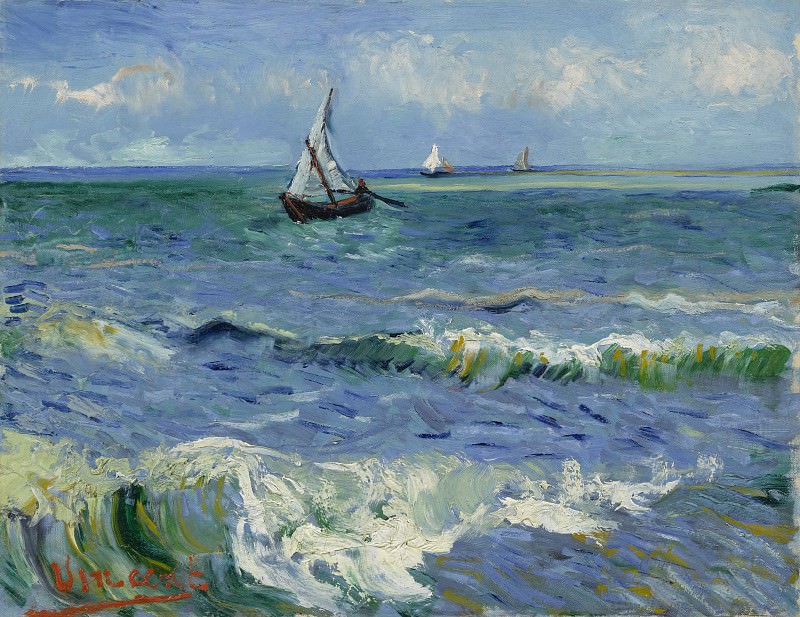Seascape at Saintes-Maries Vincent van Gogh (1853-1890)
Vincent van Gogh – Seascape at Saintes-Maries
Edit attribution
Download full size: 4540×3500 px (6,4 Mb)
Painter: Vincent van Gogh
Location: Van Gogh Museum, Amsterdam.
The painting "Seascape at Saint Marie" was painted by Van Gogh in June 1888 on the shores of the Mediterranean Sea of the fishing village of Saint Marie. The sea inspired the great painter, and during Van Gogh’s Arles period a series of paintings devoted to maritime beauty can be distinguished. Then he wrote a lot of sketches and sketches from life. Even in a letter to his brother Theodore Vincent wrote about the sea and compared its changeable color palette with the unstable color of the mackerel, because it also continuously changes its color - "then green, then purple, now it seems blue, and a second later already takes on a gray or pink hue. In the picture "Seascape in Saint-Marie," Van Gogh tried to depict the same color variability of the sea.
Description of Vincent Willem van Gogh’s painting "Seascape at Saint Marie"
The painting "Seascape at Saint Marie" was painted by Van Gogh in June 1888 on the shores of the Mediterranean Sea of the fishing village of Saint Marie. The sea inspired the great painter, and during Van Gogh’s Arles period a series of paintings devoted to maritime beauty can be distinguished. Then he wrote a lot of sketches and sketches from life.
Even in a letter to his brother Theodore Vincent wrote about the sea and compared its changeable color palette with the unstable color of the mackerel, because it also continuously changes its color - "then green, then purple, now it seems blue, and a second later already takes on a gray or pink hue.
In the picture "Seascape in Saint-Marie," Van Gogh tried to depict the same color variability of the sea. The artist wove a palette of blue, green and orange colors, the transition of which from one to another, recreate an extraordinary gradation of colors. In each shimmer, you can feel the life, you can hear the sound of the surf. Van Gogh clearly accentuated the waves and the vastness of the sea, merging into a single whole on the horizon with the sky.
He loved the sea and tried with every stroke to convey the realism of his feelings, which caused him the Mediterranean sea every minute uniqueness.
The artist perfectly managed to convey the unsurpassed beauty of the sea and the constancy of its motion.
In the foreground he depicted massive crests of waves, and the main accent in the composition made a small fishing boat, which the wave tilted on one karma. In doing so, he once again emphasized the infinite motion of the sea.
Van Gogh made his signature on the picture with red paint, which is not typical for him. He explained that he wanted to maintain the contrast with the green of the water.
Today, the painting "Seascape at Saint-Marie" is in the Van Gogh Art Museum in Amsterdam.
Кому понравилось
Пожалуйста, подождите
На эту операцию может потребоваться несколько секунд.
Информация появится в новом окне,
если открытие новых окон не запрещено в настройках вашего браузера.
You need to login
Для работы с коллекциями – пожалуйста, войдите в аккаунт (open in new window).




















COMMENTS: 1 Ответы
Живое море! движение!
You cannot comment Why?
Further out, the sea calms slightly, with larger, undulating swells. On the horizon, a sliver of pale yellow land meets the tranquil blue of the sky, which is dotted with white, cumulous clouds. Three sailboats are visible on the water: one prominent, darker boat with a single sail is closer, positioned slightly left of center, with a lone figure at the oars. Two other, smaller sailboats with white sails are further in the distance, appearing as delicate shapes against the vast expanse of the sea.
Van Goghs characteristic impasto technique is evident throughout, with thick application of paint that gives the textured surface a palpable energy. The colors, while representing a natural scene, are intensified, with vibrant blues dominating the water and sky, and the white of the waves and clouds standing out sharply.
The subtexts of this painting can be interpreted in several ways. The powerful, almost turbulent waves in the foreground might symbolize the artists own inner turmoil or the harsh realities of life. However, the presence of the sailboats, navigating these waters, could suggest resilience, hope, or the journey of life. The calm expanse of the sea and sky in the distance and the tiny sailboats on the horizon might represent a sense of peace, aspiration, or the mysteries of the universe. Van Goghs intense connection to nature and his expressive use of color are central to the emotional impact of the work, allowing for personal interpretations of struggle, tranquility, and the human spirits capacity to endure and find beauty amidst the immensity of existence.